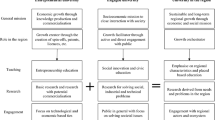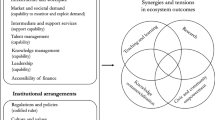Abstract
This study provides a profile of the actions taken by Australian universities to diversify their revenue streams in order to generate more independent (non-government) income. Marginson’s taxonomy of Australian universities is used to catergorise universities and contrast levels of independent income (Marginson and Considine 2000). This study finds that some Australian universities have used isomorphic tactics in their attempts to diversify their revenue streams. Unitechs (Universities of Technology) and New Universities are over-reliant upon income earned from overseas student fees, whilst earning comparatively small amounts of revenue from Royalties, Trademarks and Licences, Consultancy, Contract Research and Investments. This work discusses the dangers inherent in over-reliance on a single type of independent income. It argues that if Australian universities seek to enhance their success competing in global research, staff and student markets then they need to augment efforts to diversify revenue streams with structural and cultural changes, transforming themselves from being rigid hierarchical public bureaucracies to become more flexible network enterprises (Castells 2000).
Similar content being viewed by others
References
Australian Research Council, Commonwealth Scientific and Industrial Research Organisation and Council, N. H. a. M. R. (2000). National Survey of Research Commercialisation. http://www.arc.gov.au/publications/commercialisation/AURC003-web.pdf.
T. Becher M. Kogan (1992) Process and Structure in Higher Education Routledge London
M. Castells (2000) The Information Age: Economy, Society and Culture: The Rise of the Network Society Basil Blackwell Oxford
CHEPS and CPB (2001). Higher Education Reform: Getting the Incentives Right. http://www.cpb.nl/nl/pub/bijzonder/29/bijz29.pdf.
B. Clark (1998) Creating Entrepreneurial Universities: Organisational Pathways of Transformation Pergamon Oxford
T. Coady (Eds) (2000) Why Universities Matter: A Conversation about values, means and directions Allen and Unwin Sydney
Commonwealth Government (1996). Higher Education Funding Act (1988) as amended Higher Education Legislation Amendment Act 1996 (No. 74, 1976). http://scaleplus.law.gov.au/html/pasteact/0/108/0/PA000220.htm.
S. Cooper J. Hinkson G. Sharp (Eds) (2002) Scholars and Entrepreneurs: The Universities in Crisis Arena Publications Association Melbourne
de Boer, H., Huisman, J., Klemperer, A., van der Meulen, B., Neave, G., Theisens, H. and van der Wende, M. (2002). Academia in the 21st century: An analysis of trends and perspectives in higher education and research. http://www.awt.nl/nl/pdf/as28.pdf.
DEET (1995). Instructions for the Preparation of Annual Financial Reports by Australian Higher Education Institutions: Data for the 1995 Year. http://www.detya.gov.au/highered/statspubs.
DEETYA (1998). Financial Analysis of Universities’ Financial Statements, 1993–1996. http://www.detya.gov.au/highered/pub.
DEST (2001a). Guidelines for the Preparation of Annual Financial Reports for the 2001 Reporting Period by Australian Higher Education Institutions. http://www.detya.gov.au/highered/statspubs.
DEST (2001b). National Report on Higher Education in Australia. http://www.detya.gov.au/highered/publications.
DEST (2001c). Selected Higher Education Statistics: Finance 2001. http://www.detya.gov.au/highered/stats/pubs.
DEST (2001d). Selected Higher Education Statistics: Students 2001. http://www.detya. gov.au/highered/stats/pubs.
DEST (2002). 2002 HECS, PELS & Fees Manual. http://www.hecs.gov.au/manual/02/ htm/chapter2htm#2.1Student.
DETYA (1995a). Selected Higher Education Statistics: Finance 1995. http://www.detya. gov.au/highered/statpubs.htm#financepubs.
DETYA (1995b). Selected Higher Education Statistics: Students 1995. http://www.detya. gov.au/highered/stats.pubs.
DETYA (1998). Hecs and Fees Manual. http://www.ftp//ftp.deetya.gov.au/pub/hed/ hecsfees98.pdf.
DETYA (2001). The Regulatory Environment Applying to Universities. http://www.detya. gov.au/highered/eippubs/eip01_19default.htm.
P. Elsmore (2001) Organisational Culture: Organisational Change? Gower Hampshire
H. Etzkowitz (2003) ArticleTitle‘Research groups as “quasi firms”: the invention of the entrepreneurial university’ Research Policy 32 109–121 Occurrence Handle10.1016/S0048-7333(02)00009-4
H. Etzkowitz A. Webster C. Gebhardt B. R. CantisanoTerra (2000) ArticleTitle‘The future of the university & the university of the future: evolution of ivory tower to entrepreneurial paradigm’ Research Policy 29 313–330 Occurrence Handle10.1016/S0048-7333(99)00069-4
M. Gibbons P. Scott H. Nowotny (Eds) (2001) Rethinking Science Polity Press London
P. Gumport (2000) ArticleTitle’Academic restructuring: Organisational change and institutional imperatives’ Higher Education 39 67–91 Occurrence Handle10.1023/A:1003859026301
R. Harding (2002) ArticleTitle‘Evolution, Path Dependency, Learning and Innovation’ Minerva 40 289–299 Occurrence Handle10.1023/A:1019516424249
Hermon-Taylor R. (1985). In Organizational Strategy and Change: New Views on Formulating and Implementing Strategic Decisions ed. Pennings J.M.. Jossey-Bass Publishers, San Francisco pp. 383–411.
G. Hofstede (1997) Cultures and Organisations: Software of the Mind McGraw Hill New York
IDP (2002). Global Student Mobility 2025: Forecasts of the Global Demand for International Higher Education. http://www.idp.edu.au/services/marketing/research.
IDP Education Australia (2003). Facts: Latest Statistics. http://www.idp.edu.au/services/marketing/research_consult/fast_facts/latest_statistics.as.
A. Kezar P. Eckel (2002) ArticleTitle‘The Effect of Institutional Culture on Change Strategies in Higher Education’ Higher Education 73 435–460
Knight, J. (2002). Trade in Higher Education Services: The Implications of the GATS. http://www.obhe.ac.uk/resources.html.
Koelman, J. and de Vries, P. (1999). In From the Eye of the Storm: Higher Education’s Changing Institution (Eds, Jongbloed, B.,Maassen, P. and Neave, G.). Dordrecht: Kluwer, pp. 165–185.
S. Marginson (1997) Markets in Education Allen and Unwin Sydney
S. Marginson M. Considine (2000) The Enterprise University: Power, Governance and Reinvention in Australia Cambridge University Press Cambridge
Marginson, S., Considine, M., Sheehan, P. and Kumnick, M. (2001). Performance of Australia as a Knowledge Nation: Report to the Chifley Research Centre. http://www.education.monash.edu.au/centres/mcrie/resources/Chifley-KnowledgeNationrev2106. pdf.
G. Mc Burnie C. Ziguras (2003) ArticleTitle‘Remaking the world in our own image:Australia’s efforts to liberalise trade in education services’ Australian Journal of Education 47 217–234
OECD (2002). OECD/US forum on Trade in Educational Services. http://www.oecd/dataoecd/6/33/2753171.pdf.
OECD (2003). Internationalisation and Trade. http://www.oecd/imhe.
C. Oliver (1997) ArticleTitle‘Sustainable, Competitive Advantage: Combining Institutional and Resource-Based Views’ Strategic Management Journal 18 697–713 Occurrence Handle10.1002/(SICI)1097-0266(199710)18:9<697::AID-SMJ909>3.0.CO;2-C
Productivity Commission (2002). University Resourcing: Australia in an International Context: Draft Research Report. http://www.pc.gov.au.
P. Ramsden (1999) ArticleTitle‘Predicting institutional research performance from published indicators: A test of classification of Australian university types’ Higher Education 37 341–358 Occurrence Handle10.1023/A:1003692220956
M. Ricketts (2002) The Economics of Business Enterprise Cheltenham Edward, Elgar United Kingdom
J.A. Schumpeter (1934) The Theory of Economic Development: An Inquiry into Profit, Capital, Credit, Interest, and the Business Cycle Harvard University Press Cambridge
T. Turpin R. Iredale P. Crinnion (2002) ArticleTitle‘The Internationalization of Higher Education: Implications for Australia and its Education “Clients”’ Minerva 40 327–340 Occurrence Handle10.1023/A:1020933923270
Van Damme, D. (2002). Internationalisation and Quality Assurances-Towards Worldwide Accreditation. http://www.esib.org/documents/quality.htm.
M. Wende ParticleVan Der (2003) ArticleTitle’Globalisation and Access to Higher Education’ Journal of Studies in International Education 7 193–206 Occurrence Handle10.1177/1028315303007002006
Van Vught F. (1996). In The Mockers and the Mocked: Comparative Perspectives on Differentiation, Convergence and Diversity in Higher Education (Eds,Meek, L., Goedegebuure, L., Kivinen, O. and Rinne, R.). Paris: IAU Press and Pergamon.
Author information
Authors and Affiliations
Corresponding author
Rights and permissions
About this article
Cite this article
Zilwa, D. Using Entrepreneurial Activities as a Means of Survival: Investigating the Processes used by Australian Universities to Diversify their Revenue Streams. High Educ 50, 387–411 (2005). https://doi.org/10.1007/s10734-004-6359-8
Issue Date:
DOI: https://doi.org/10.1007/s10734-004-6359-8




